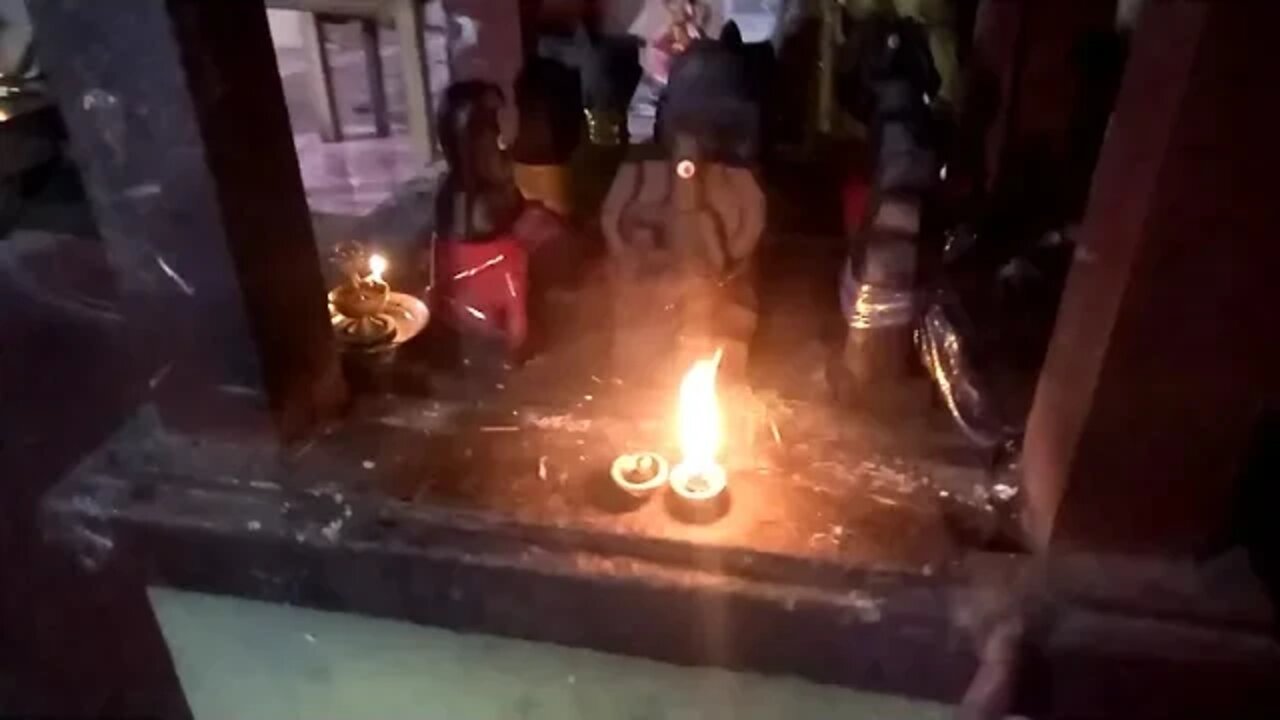Premium Only Content

Going around the nine planets ( Navagraha) at an Hindu Temple
According to Hindu astrology, a person's happiness, success, and overall wealth are all affected by something called the Navagrahas. The favorable and unfavorable, positive and negative influences of each of these nine planets are the product of a variety of circumstances, such as the precise placement of the planets on the birth chart, among other things. Jupiter, the Sun, and the Moon are all examples of sattva-natured planets. Venus and Mercury are considered to be rajas-carrying planets, whereas Mars, Saturn, Rahu, and Ketu are considered to be tamas-carrying planets.
In Vedic astrology, these nine planets are regarded as gods, each having its own unique set of abilities, nature, and characteristics. These powers, nature, and qualities are determined by the benefits or drawbacks that each planet brings to mankind.
When depicted with the other planets, the Sun, also known as Surya, is typically positioned in the middle of the group while looking eastward. All of the other planets are orbiting about him, but they are not facing in any direction that would bring them into contact with one another. He rides a chariot that only has one wheel and is pulled by seven horses, each of which represents one of the seven hues that make up white light as well as one of the seven days of the week. Ravi is an additional name for him.
Moon (Chandra): In the depictions, he is never seen to be a fully developed individual. Only his upper torso is depicted while he rides in a chariot carried by 10 horses. Both of his hands are carrying a lotus in each of them. It is also possible to refer to him as Soma.
Mars, also known as Mangala, is a fierce god who is depicted with two hands wielding weapons and two hands making mudras. The vehicle that he uses is a ram.
Mercury, also known as Buddha, is depicted with four hands and driving a chariot or a lion. He has four hands total, and three of them are holding various weapons (a sword, a shield, and a mace), while the other hand is performing a mudra.
Jupiter, also known as Brihaspathi, is lauded in the Rig Veda for his role as the instructor of the gods. He is depicted riding in a chariot that is being carried by eight horses, each of which represents a different field of knowledge.
Venus, also known as Sukra, is known as the instructor of the Demons. He travels around on a chariot that is driven by eight horses and he has four hands. A staff, a rosary, and a vessel made of gold are held in three of his hands, while the fourth hand is positioned in a mudra.
Sani, also known as Saturn, is a God who is feared by people because his planetary location has the power to build or shatter individuals' fortunes. He is typically depicted with four hands while astride either a chariot, a buffalo, or even a vulture. He has three hands, and in two of them, he is holding a bow, a javelin, and an arrow, while the hand he is not using is performing a mudra.
He has some similarities in appearance to the god Budha (Mercury), yet the two deities are fundamentally different. In the original story, Budha is depicted as riding a white lion, while here he is seen riding a black lion. However, exactly like Budha, he wields each and every one of the same weapons.
Ketu: In Sanskrit, Ketu means a comet. It is stated that he possesses the tail of a serpent somewhere within his body, and his personality is considered to be extremely similar to that of a comet. In some of the images, he is depicted wielding a mace while also sitting atop a vulture.
-
 1:15:15
1:15:15
Glenn Greenwald
4 hours agoWeek in Review: Lee Fang and Leighton Woodhouse on Ukraine War and NYT Piece Revealing Tensions within Trump Admin; PLUS: Lee Fang Takes Audience Questions on DOGE and Big Tech | SYSTEM UPDATE #420
41K36 -
 1:03:30
1:03:30
Sarah Westall
6 hours agoMassive Government Overhaul: FBI, CIA, IRS and more to be Gutted w/ Sam Anthony
53.3K13 -
 1:07:40
1:07:40
IsaacButterfield
6 hours ago $1.35 earnedAustralia Under Attack | Trump's State of the Union | All LGBTQ Cast (W Guest Frenchy)
17.6K1 -
 1:23:37
1:23:37
Edge of Wonder
6 hours agoIs Your Car Collecting Your Biodata? Whistleblower Exposes Dark Agenda
21.5K2 -
 2:08:50
2:08:50
Quite Frankly
9 hours ago"A Rat at HHS, Gene Hackman, Musical Extras" ft. J Gulinello 3/7/25
27.9K5 -
 55:49
55:49
LFA TV
1 day agoGermany Started Two World Wars and Now Wants Nuclear Weapons | TRUMPET DAILY 3.7.25 7PM
26.8K24 -
 1:34:38
1:34:38
2 MIKES LIVE
5 hours ago2 MIKES LIVE #189 Open Mike Friday (Sort Of)
20.6K -
 1:48:14
1:48:14
Right Side Broadcasting Network
13 hours agoLIVE REPLAY: President Trump Delivers Remarks at The White House Digital Assets Summit - 3/7/25
142K42 -
 2:07:17
2:07:17
The Quartering
10 hours agoTrump Goes Ballistic On Russia & Ukraine Gets Results, Democrat Cringe, FBI Arrests Military Men
140K79 -
 1:33:20
1:33:20
Sean Unpaved
9 hours agoWhat Could The 2025 NFL Draft & Season Look Like with Special Guest 2x Super Bowl Champ Phil Simms
49.4K6